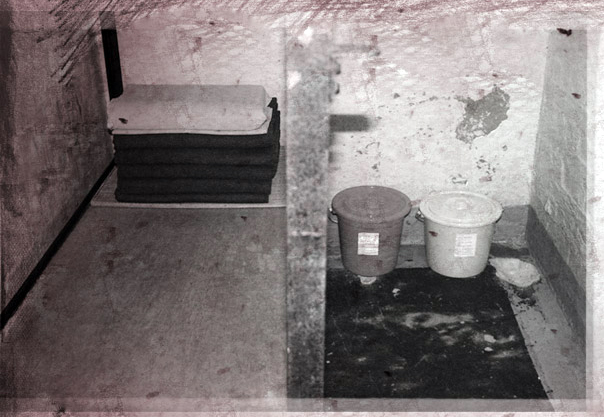Home>Victoria Prison>What were the punishments, meals and work in Victoria Prison?
What were the punishments, meals and work in Victoria Prison?

In each cell, besides the bed, there were two plastic buckets:
one red and one yellow, which were used for washing and toilet purposes.
Photography by Chan Tin Kuen
Forms of punishment in Prison
For those who were disobedient of prison regulations, the prison authorities would dole out punishment in various forms. In 1852, a treadwheel was installed in the prison. The punished prisoner had to keep operating the treadwheel until exhaustion. In his tour of the 1876 of the Victoria Gaol, Guo Gaoshou mentioned, “There was an iron crank in the confinement room which was operated by hand. The inmate was required to turn the crank 14,000 times each day. Those who failed to meet the target would be given less food.” Turning the crank was a form of punishment, and the crank itself came with an adjustment function to increase its resistance, so that inmates needed to spend greater effort turning it.
In 1876, the Prison introduced a form of punishment whereby the inmates were given limited sustenance. Offending Chinese inmates were given only one bowl of rice with one glass of water for each meal, 3 times a day; European or Indian inmates were given bread or pita, and also a glass or water. This form of punishment was abolished only in 1981. Offenders were also required to do manual labour in the day time and were deprived of any form of entertainment.
In the past corporal punishment was permitted in the prison. The jailers were charged with the caning of the prisoner after the number of strokes was determined by the court. This form of fearsome punishment was abolished only in November 1990.
Daily meals
In the old days, inmates were given only 2 meals per day – four small salted fish with rice every meal, and vegetable once every 10 days. Meat was provided once a year. Later, the quality of the meals improved and 4 meals were provided – breakfast, lunch, dinner and a late-night snack around 9pm. Four different choices of food were available each meal, including Chinese, Indian, Western and Vegetarian; those who were sick or had other religious beliefs were given special treatment.
For inmates, life in prison mostly consisted of work. They left their cell at 7 in the morning, had breakfast at the canteen, then began a full day of work. After a simple lunch at 12, work resumed at 2 in the afternoon until 5. After dinner and rest, inmates were returned to their cells at 7 at night. In each cell there were two plastic buckets: one red and one yellow, which were used for washing and toilet purposes. Since the closing of the prison, the buckets were removed and only the bunk beds remained.
Types of work
If an inmate was in good health, the prison authorities would assign work according to his/her academic qualifications and specialty. This included maintenance of utensils, cleaning, cooking, washing and ironing, sewing, iron mongering, book binding, and making road signs, mail boxes and trash cans. Since 1953, instead of a stipend upon release, wages were issued so that inmates were motivated to work. The wage issued differed according the technique required, the position and experience.
Pottinger Street, located just outside the Central Police Station, was lined by stone slabs. Rumours had it that the work was done by the inmates of the old days. Some of the buildings in the prison were hand-built by the inmates. Inmates were also required to clean their cell and toilets under the monitoring of the staff, and their blankets and bed covers must be made according to strict requirements.
<
Back to Previous Page

Hong Kong Memory.All Rights Reserved©2014
